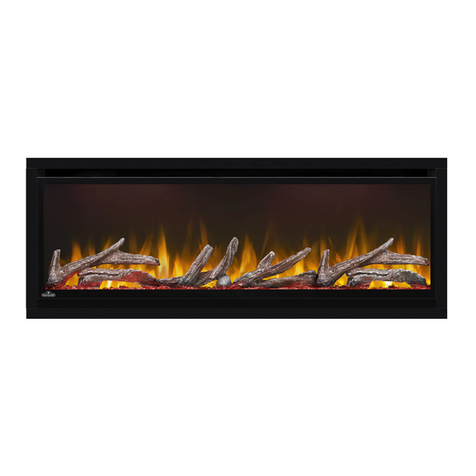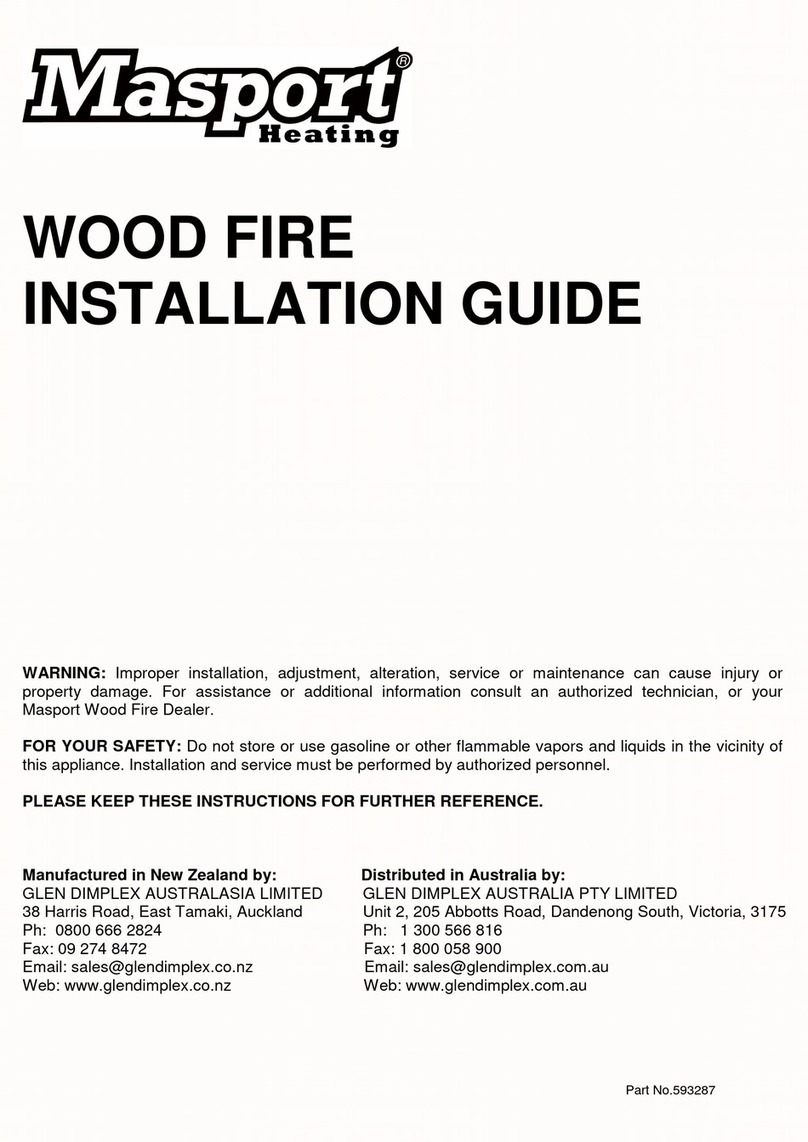
9
Figure 9
XII. OPERATING INSTRUCTIONS
For the first few days, the stove will give off an odor and a
small amount of smoke. This happens when the high
temperature paint is bonding to the metal. This is normal
and will stop when the paint is cured, and will reoccur every
time you repaint or touch up your stove.
1. Starting a fire. Crumble three or four full sheets of
newspaper and place them on the flow of your SIERRA
stove.
2. Crisscross two layers of dry kindling on the paper. Add
a few large splits of dry wood on top of the kindling.
3. Make sure the primary air controls are fully open. Also
be sure that the bypass lever is open.
4. Light the paper under the kindling with a match or
lighter. Do not use gasoline, lighter fluid, charcoal
starter, kerosene, or any other such fuel to start a fire in
a woodstove.
5. At higher altitudes, or when starting a fire on a very cold
chimney, it may be necessary to leave the door cracked
open for a few minutes, no longer than 5 minutes, to
encourage a hot fire.
NEVER LEAVE YOUR STOVE UNATTENDED WHEN
THE DOOR IS UNLATCHED.
6. W hen the kindling has been consumed and larger splits
are burning well, load the stove to the level you desire,
using well-seasoned, dry wood.
(Wet wood does not heat well.)
DO NOT BURN COAL IN THIS UNIT!
Close the doors and continue to burn the stove on high
and with the bypass open until the wood becomes fully
involved. It is not necessary to use additional grates or
irons to support the fuel.
7. Once your chimney and stove are warmed up and
drawing well, close the air inlets to the desired heat
output. Close the bypass before slowing down the air.
Reload when convenient, but always while you still have
a good bed of glowing embers. Always open the bypass
3 minutes before opening the door to reload. Never
close the bypass immediately after adding fresh wood to
the fire.
8. When opening the door to reload or to poke the fire,
open the bypass first. Crack the door and hesitate just a
few seconds before swinging it open. All this is to
prevent flashbacks which occur when a very smoky fire
suddenly is given a lot of oxygen.
Every stove chim ney combination functions a little
differently. Be patient, and expect the stove to be
different in January when it is very cold outside, than it
was in September when the weather was warmer. Once
a chimney is warmed up, its draft is a function of how
muchwarmer it is than the air around it. On mild fall
evenings, a stove can appear to be finicky and difficult.
However, the very next night, in the midst of a fall storm,
it might act like acompletely different stove.
9. As you burn your stove and wood is consumed, ashes
will fall through the grate and into the ash pan. Also, as
you rearrange your ashes you should work them toward
the ash pan. W hen the ash pan becomes full (this
should be checked daily), pull the ash pan 3/4 of the way
out of the stove. Remove the ashes with a shovel and
place them in a metal container with a tight-fitting lid.
Assume that there are still hot coals mixed in the. There
usually are for as long as three days.
DO NOT PLACE ASHES WITH THE GARBAGE OR
NEAR ANYTHING COMBUSTIBLE.
THE BEST IDEA IS TO LEAVE THEM OUTSIDE, THREE
FEET AWAY FROM THE HOUSE IN A METAL
CONTAINER FOR THREE DAYS.
Ashes should be placed in a metal container with a tight
fitting lid. The closed container of ashes should be placed
on a non-combustible floor or on the ground, well away
from all combustible materials, ending final disposal. If the
ashes are disposed of by burial in soil orotherwise locally
dispersed, they should be retained in the closed container
until all cinders have thoroughly cooled. Ash removal doors
must be closed when in operation.
DEFINITION AND PURPOSE OF A CATALYTIC
COMBUSTOR
Catalytic combustors for woodstoves (cats) are similar in
principle to catalytic converters on automobiles. The big
difference is that the heat generated by your woodstove
combustor is put to use heating your home instead of
being dumped out the tailpipe of your car. Catalytic
combustors cause wood smoke to burn at very low
temperatures, releasing energy that would otherwise be
lost in the form of smoke.
As smoke passes through the combustor, a rare metal
coating on the ceramic base of the combustor changes fuel
molecules in the smoke so that they burn at 500 to 600
degrees Fahrenheit, instead of the more normal 1000 to 1200
degrees Fahrenheit. In addition to making stoves burn
cleaner, combustors improve their heating efficiency. On the
average, you will receive 30 to 50% more heat from each
piece of wood, up to 90% less creosote and because the cat
burns most of the smoke, 90% less air pollution than you
would from burning a comparable stove. Of course, results
may be higher or lower depending on the operation, chimney
draft, and combustor age.
OPERATION
Achieving catalytic light off. During each burning cycle, the
temperature within the stove should be raised high enough
to cause the catalyst to become active or “light off.” The
most convenient way to do this is during fuel loading while
warming up the wood and the chimney. With a new
combustor, smoke temperatures between 500 and 600
degrees (F) will begin catalytic burning. (Since the
combustors sit right above a roaring fire, this is not hard to





























